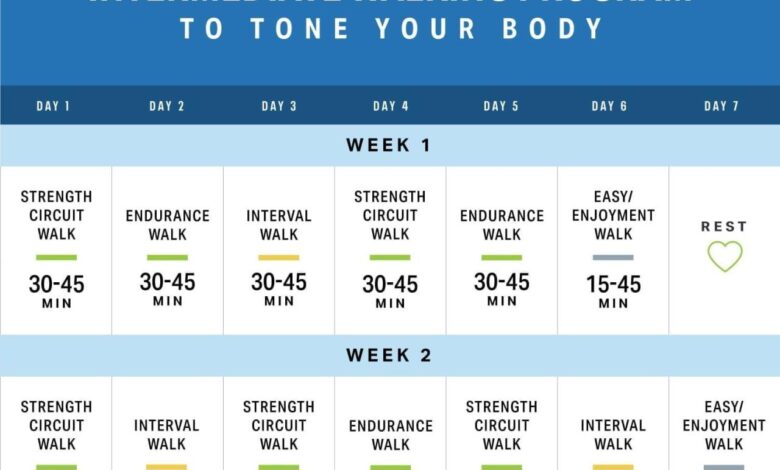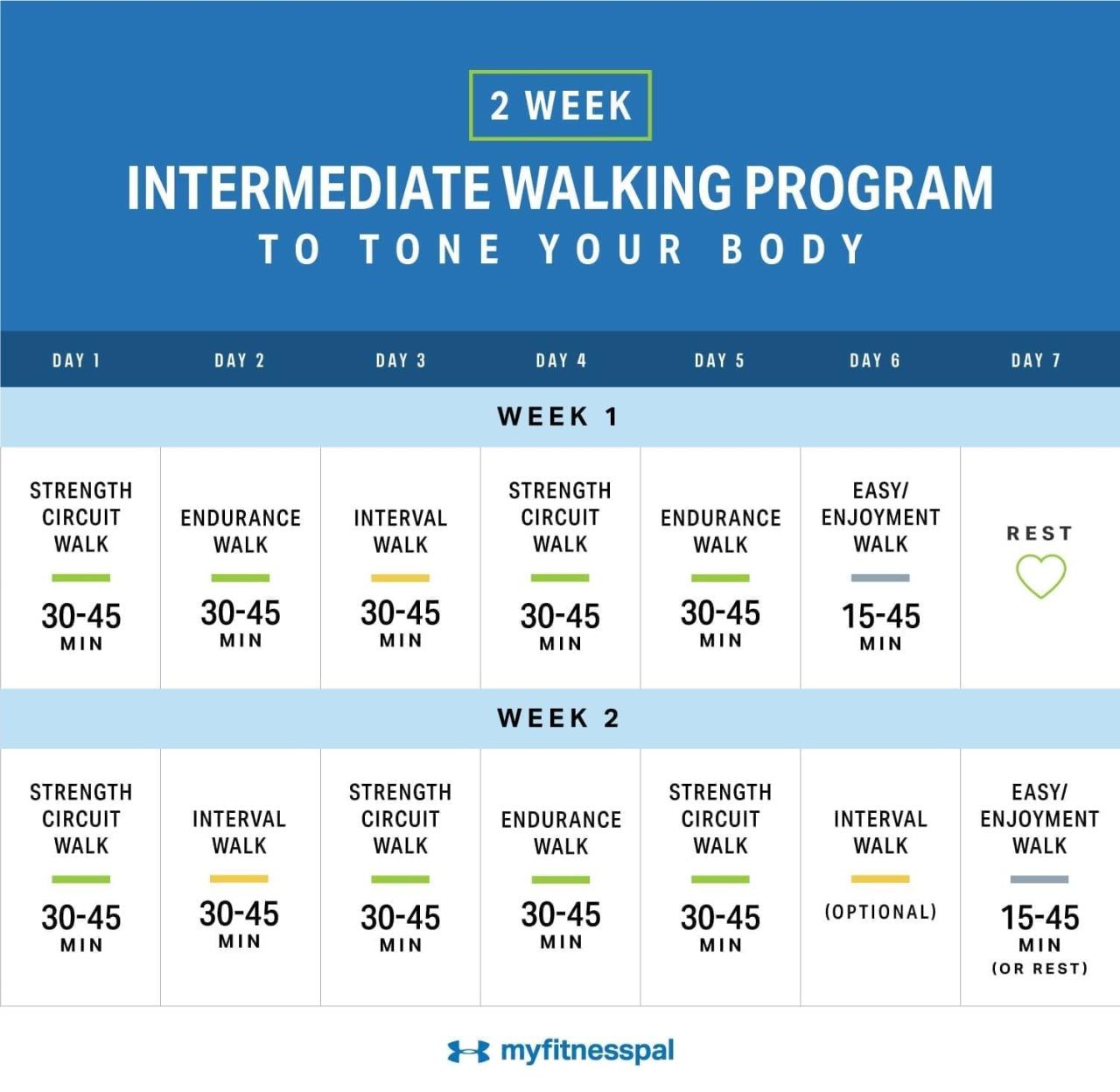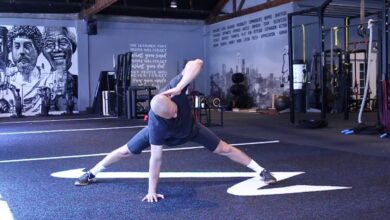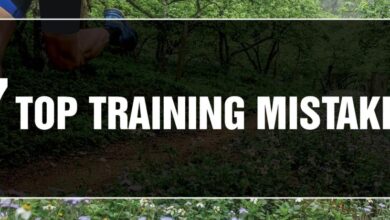
Your 2 Week Mix & Match Walking Guide: Get Fit & Explore
Your 2 week mix and match walking guide – Your 2 Week Mix & Match Walking Guide is your key to unlocking a healthier, happier you! Ready to ditch the treadmill and embrace the open road? This guide is designed to help you build a sustainable walking routine that’s as exciting as it is effective.
Whether you’re a seasoned walker or just starting out, this plan offers a flexible mix of distances, terrains, and intensity levels to keep you motivated and engaged.
We’ll explore the benefits of walking, create a structured two-week plan that you can adapt to your own fitness level and goals, and delve into techniques, safety tips, and motivation strategies. Get ready to discover the joy of walking, one step at a time!
A Two-Week Walking Plan for Variety and Fitness

Walking is a fantastic way to improve your overall health and well-being. It’s a low-impact exercise that can be enjoyed by people of all ages and fitness levels. Regular walking offers numerous benefits, including weight management, improved cardiovascular health, reduced risk of chronic diseases, boosted mood, and enhanced sleep quality.This two-week mix-and-match walking guide provides a structured plan with flexibility, allowing you to tailor it to your individual preferences and fitness goals.
The guide features a variety of walking routines, including distance, pace, and terrain variations. You can choose the walks that best suit your current fitness level and gradually increase the intensity and duration as you progress.
The Structure of the Two-Week Plan
The two-week plan is designed to be flexible and adaptable. Each day includes a suggested walking routine, but you can modify it to suit your schedule and preferences. The plan is divided into two weeks, with each week featuring a mix of different types of walks.
Week 1
- Day 1:Easy 30-minute walk at a comfortable pace. Focus on enjoying the scenery and getting your body moving.
- Day 2:Moderate 45-minute walk with some hills or inclines to challenge yourself.
- Day 3:Rest day. Allow your body to recover and replenish.
- Day 4:Fast-paced 30-minute walk, aiming for a brisk pace to elevate your heart rate.
- Day 5:Long 60-minute walk, exploring a new park or trail.
- Day 6:Easy 30-minute walk, focusing on relaxation and enjoying the outdoors.
- Day 7:Rest day. Take a break and recharge.
Week 2
- Day 1:Moderate 45-minute walk with a mix of flat and hilly terrain.
- Day 2:Fast-paced 30-minute walk, aiming for a brisk pace to elevate your heart rate.
- Day 3:Rest day. Allow your body to recover and replenish.
- Day 4:Long 60-minute walk, exploring a new park or trail.
- Day 5:Easy 30-minute walk, focusing on relaxation and enjoying the outdoors.
- Day 6:Moderate 45-minute walk with some hills or inclines to challenge yourself.
- Day 7:Rest day. Take a break and recharge.
Motivation and Goal Setting
Walking is a fantastic activity that offers numerous physical and mental benefits. However, staying motivated and consistent with your walking routine can be challenging, especially when you’re starting. Setting realistic goals, tracking progress, and listening to your body are essential strategies to keep you engaged and prevent burnout.
Setting Realistic Goals
It’s crucial to set achievable goals that align with your current fitness level and lifestyle. Starting with small, attainable goals will build confidence and momentum.
- Begin with a manageable walking schedule:Instead of aiming for a long daily walk, start with shorter walks a few times a week.
- Gradually increase your distance or duration:As you get fitter, gradually increase the distance or duration of your walks. This gradual approach prevents overexertion and helps you adapt to the increased activity.
- Focus on consistency:Regular walking is more important than occasional long walks. Aim for consistency over intensity in the beginning.
Tracking Progress
Tracking your progress can be highly motivating and helps you stay accountable.
- Use a fitness tracker or app:These tools can automatically track your steps, distance, and calories burned, providing valuable insights into your progress.
- Keep a walking journal:Record your daily walks, including the distance, duration, and any observations about how you felt during the walk.
- Celebrate milestones:Acknowledge and celebrate your achievements, no matter how small. This reinforces positive behavior and motivates you to continue.
Listening to Your Body
Your body is a valuable source of information. It’s essential to listen to its signals and adjust your routine as needed.
My 2-week mix and match walking guide is all about finding the perfect balance between challenging yourself and listening to your body. It’s designed to help you build endurance and burn calories, and you can even incorporate some core work to strengthen your abdominal muscles.
If you’re looking for a more focused approach to building those abs, I recommend checking out the 21 day strong abs program. Once you’ve got those core muscles firing, you’ll find that your walking routine feels even more invigorating!
- Rest when you need it:Don’t push yourself too hard, especially when starting. If you feel tired or sore, take a break or shorten your walk.
- Listen to pain signals:If you experience any sharp pain or discomfort, stop walking and consult with a healthcare professional.
- Adjust your pace and intensity:As you get fitter, you can gradually increase the pace and intensity of your walks. But don’t be afraid to slow down if you need to.
Staying Motivated
Staying motivated can be a challenge, but there are strategies to keep you going.
My 2-week mix-and-match walking guide is all about finding the perfect balance for your body and goals. Some days, you might crave a brisk walk to clear your head, while others, you might feel like taking on a longer trek.
If you’re wondering whether a long walk is better than a short run, check out this insightful article: should you choose a long walk over a short run. My guide helps you tailor your walking routine to your needs, whether it’s a quick 30-minute stroll or a leisurely hour-long exploration.
- Find a walking buddy:Having a walking partner can make walks more enjoyable and help you stay accountable.
- Explore new routes:Varying your walking routes can keep things interesting and prevent boredom.
- Set rewards:Reward yourself for reaching your goals, whether it’s a new pair of walking shoes or a special treat.
- Listen to music or podcasts:Walking can be a great time to listen to your favorite music or podcasts.
- Focus on the benefits:Remember the numerous benefits of walking, such as improved fitness, reduced stress, and better sleep.
Nutritional Considerations
Fueling your body with the right nutrients is crucial for maximizing your walking performance and overall health. Proper nutrition plays a vital role in supporting energy levels, muscle recovery, and immune function, all of which are essential for a consistent and enjoyable walking routine.
Pre- and Post-Walk Nutrition, Your 2 week mix and match walking guide
Before a walk, it’s important to consume a light snack or meal that provides sustained energy. This will help you maintain your pace and endurance throughout your workout. Post-walk nutrition is equally important for replenishing energy stores and aiding muscle recovery.
My two-week mix-and-match walking guide is all about exploring your city in a new way, with each day offering a different route and activity. One of my favorite stops along the way is the local farmers market, where I stock up on fresh, seasonal produce.
I love finding a beautiful bunch of asparagus and whipping up one of the delicious recipes from 12 farmers market friendly asparagus recipes. After a hearty lunch, I’m ready to hit the pavement again, exploring hidden gems and soaking up the vibrant energy of my neighborhood.
- Pre-walk snacks: Choose snacks that are high in carbohydrates and moderate in protein, such as a banana with peanut butter, a handful of almonds, or a small bowl of oatmeal. These options provide sustained energy without feeling heavy or causing digestive discomfort.
- Post-walk meals: After your walk, focus on meals that are rich in protein and carbohydrates to support muscle repair and replenish glycogen stores. Consider a chicken breast with quinoa, a Greek yogurt with fruit and granola, or a tuna salad sandwich on whole-grain bread.
Hydration
Water is essential for maintaining proper hydration levels during physical activity. Dehydration can lead to fatigue, cramps, and decreased performance.
It is recommended to drink water before, during, and after your walks. Aim for 16-20 ounces of water two hours before your walk, 8 ounces every 20-30 minutes during your walk, and another 16-20 ounces after your walk.
Importance of Proper Nutrition for Overall Health and Fitness
A balanced diet that includes plenty of fruits, vegetables, whole grains, lean protein, and healthy fats is essential for overall health and fitness. This type of diet provides the necessary nutrients to support your body’s various functions, including energy production, muscle growth, and immune system function.
- Energy levels: A balanced diet provides the necessary carbohydrates, protein, and fats to fuel your body and maintain energy levels throughout the day.
- Muscle recovery: Adequate protein intake is crucial for muscle growth and repair, especially after exercise. Protein helps rebuild muscle tissue and promotes recovery.
- Immune function: A healthy diet rich in vitamins and minerals supports a strong immune system, helping to prevent illness and maintain overall well-being.
Additional Resources and Tips

As you embark on your walking journey, remember that you’re not alone. There are numerous resources and communities that can support you, inspire you, and help you stay motivated. Let’s explore some helpful tools and inspiring stories that can enhance your walking experience.
Apps and Websites
Technology can be a powerful ally in your walking endeavors. Several apps and websites offer features that can track your progress, provide motivation, and connect you with a supportive community.
- Fitness Tracking Apps:Apps like Strava, MapMyWalk, and Google Fit allow you to track your distance, pace, calories burned, and other metrics. They also provide features for setting goals, joining challenges, and connecting with friends.
- Walking Challenges and Groups:Websites like Couch to 5K and the American Heart Association offer structured walking programs and online communities for support and motivation.
- Podcasts and Audiobooks:Listening to podcasts or audiobooks during your walks can make the time fly by and keep you entertained.
Inspiring Stories
Hearing about others who have achieved their fitness goals through walking can be incredibly motivating. These stories demonstrate the power of consistency and the transformative impact of walking on both physical and mental well-being.
- Weight Loss Success:Many individuals have achieved significant weight loss through regular walking. Their stories highlight the importance of setting realistic goals, finding a walking routine that fits their lifestyle, and staying consistent over time.
- Improved Health and Fitness:Walking has been shown to improve cardiovascular health, reduce the risk of chronic diseases, and boost mood. Stories of people who have experienced these benefits through walking can inspire others to adopt this healthy habit.
- Overcoming Challenges:Some individuals have used walking to overcome physical limitations or mental health challenges. Their stories demonstrate the resilience and determination that can be fostered through walking.
Staying Committed
Maintaining a consistent walking routine can be challenging, but there are strategies that can help you stay motivated and on track.
- Set Realistic Goals:Start with achievable goals and gradually increase the distance or intensity of your walks as you progress. Avoid setting goals that are too ambitious, as this can lead to discouragement.
- Find a Walking Buddy:Walking with a friend can make the experience more enjoyable and help you stay accountable. You can also motivate each other and celebrate each other’s progress.
- Make It a Habit:Schedule walking into your daily routine and treat it like any other important appointment. This will help you prioritize walking and make it a regular part of your life.
- Celebrate Your Successes:Acknowledge your achievements, no matter how small they may seem. Celebrate your milestones with a reward, such as a new pair of walking shoes or a healthy meal.
Closing Summary: Your 2 Week Mix And Match Walking Guide
By the end of this two-week journey, you’ll have a solid foundation for incorporating walking into your daily life. You’ll feel stronger, more energized, and ready to embrace the many benefits of this simple yet powerful activity. Remember, consistency is key, so don’t be afraid to experiment, listen to your body, and enjoy the process! Lace up your shoes, grab your water bottle, and let’s hit the pavement together!






